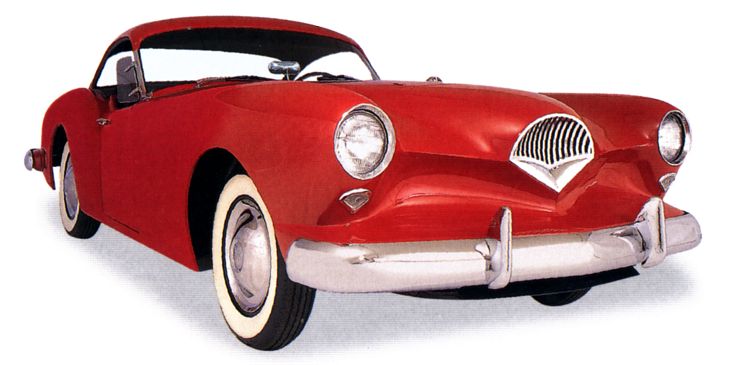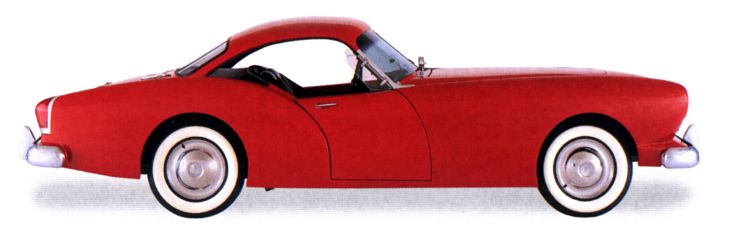Description
The Kaiser Darrin 161 Coupe was a rare design concept and an intriguing footnote in the history of Kaiser Motors—an idea that never reached series production but reflected the bold ambition and creative restlessness of its designer, Howard “Dutch” Darrin. While the roadster version became famous for its elegance and innovation, Darrin envisioned a coupe variant that would extend the same flowing, futuristic design into a more enclosed, all-weather grand touring form. The Darrin 161 Coupe remained largely a prototype concept, yet it embodied the same spirit of individuality, technical ingenuity, and sculptural beauty that made the Darrin name legendary.
The Darrin 161 series originated in the early 1950s as Kaiser Motors’ venture into the growing sports car market. Dutch Darrin, long associated with streamlined automotive design and coachbuilding artistry, wanted to create an American car that rivaled the grace and craftsmanship of European marques like Jaguar and Delahaye. The 161 Coupe shared its basic platform and mechanical layout with the Darrin 161 Roadster—built around a modified Henry J chassis with a 100-inch wheelbase and a lightweight fiberglass body—but adapted its proportions and roofline for closed-top comfort and year-round usability.
Like its open counterpart, the Darrin 161 Coupe would have been powered by the Willys “Hurricane” F-head inline-six engine, a 161 cubic inch (2.6-litre) powerplant producing about 90 horsepower and 130 lb-ft of torque. The engine’s combination of overhead intake and side exhaust valves gave it smoother breathing than the earlier flathead designs, and it was paired with a three-speed manual transmission, often equipped with overdrive. Though not a high-performance machine, the Darrin’s light weight made the most of its modest power, emphasizing balance, refinement, and precision rather than raw acceleration.
The mechanical foundation of the Coupe was identical to that of the Roadster: independent front suspension with coil springs, a solid rear axle on leaf springs, and hydraulic drum brakes. Its handling was expected to be equally agile, aided by its low center of gravity and tight body construction. The fiberglass body not only made the car lighter but also allowed Dutch Darrin to sculpt it into forms that would have been difficult to achieve in steel—smooth, organic shapes that seemed to flow seamlessly from nose to tail.
The styling of the Darrin 161 Coupe would have been its most striking aspect. Retaining the long hood, flared fenders, and trademark “Darrin dip” in the doors, the coupe added a gracefully arched roofline that flowed into a fastback-style rear deck. The effect was elegant and dynamic, giving the car a sense of motion even when standing still. The distinctive “pursed lips” grille—a hallmark of the Darrin’s front end—remained, flanked by deeply recessed headlights and a broad, smiling intake. Chrome trim was used sparingly but effectively, accentuating the beltline and window surrounds. The sliding doors, a defining feature of the Darrin Roadster, would likely have been retained in the coupe version, disappearing into the front fenders with the same dramatic flourish.
Inside, the coupe’s cabin would have carried the same minimalist luxury as the roadster’s, but with greater insulation and comfort for long-distance touring. Seating for two was standard, with the possibility of a small luggage shelf behind the seats. The dashboard design was symmetrical and refined, with round chrome-rimmed gauges, simple toggle switches, and color-coordinated upholstery. Materials such as leather or high-quality vinyl, combined with polished metal accents, created an atmosphere of understated elegance.
Had it reached production, the Kaiser Darrin 161 Coupe would have competed in the same emerging market as the early Corvette or European-inspired models like the Nash-Healey. However, by the time the Darrin went into limited production in 1954, Kaiser Motors was already in financial decline. The roadster itself sold only 435 examples before the company ceased automobile production, leaving no resources to develop a closed coupe variant. Dutch Darrin’s design sketches and a few experimental mock-ups are all that remain of the coupe concept, making it one of the most tantalizing “what ifs” in American automotive history.
While the Darrin 161 Coupe never reached the showroom floor, its vision continues to fascinate enthusiasts and designers. The concept represented what a truly elegant American gran turismo could have been—a fusion of European style and American craftsmanship, wrapped in an innovative fiberglass body decades ahead of its time.
Today, the idea of the Kaiser Darrin 161 Coupe endures as a symbol of what made the original Darrin so special: a belief that the automobile could be more than a machine—it could be an expression of artistry, individuality, and imagination. It remains one of those rare designs that transcended practicality to capture the essence of beauty in motion, a fleeting vision of what might have been if innovation and artistry had triumphed over commercial constraint.

